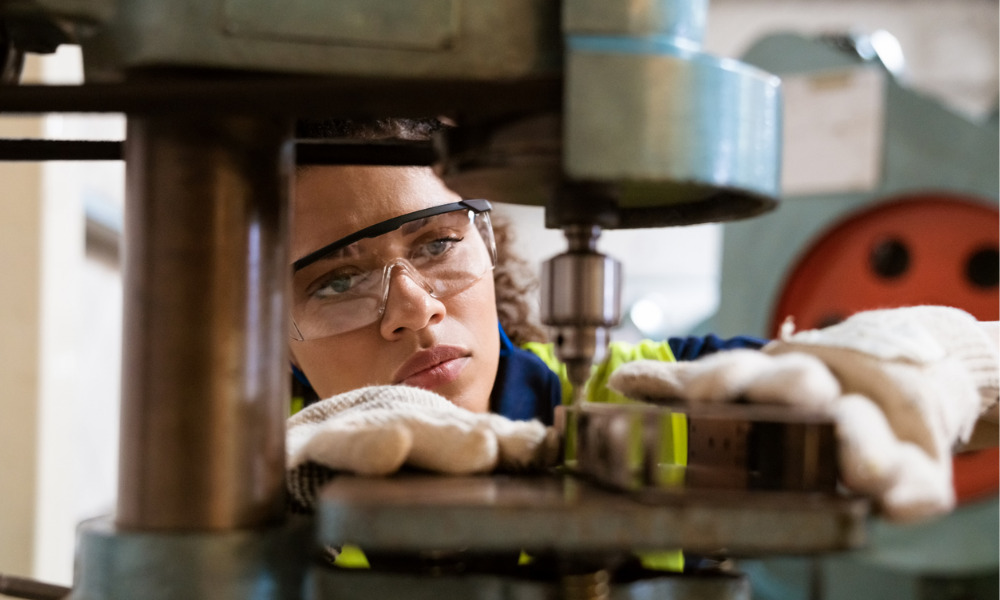Many accidents related to ladders that were too big for them, says OHS expert

In some non-traditional jobs, women are three times more likely to get injured than men. Why? One expert believes that most workplaces are not properly designed for women.
Lauded ergonomist and occupational health expert Karen Messing explains that often, and especially in industries where women are a minority, equipment, clothing and even tasks are anchored in the male experience. “There’s all kinds of different ways that the job can be ill-suited for women,” she says.
As revealed in her book, Bent out of Shape: Shame, Solidarity and Women’s Bodies at Work, Messing and her colleagues found that women had about three times as many accidents as men on a per employee basis in non-traditional workplaces (i.e. workplaces that are typically male-dominated).
Messing’s research in this case covered three specific workplaces: municipal jobs (gardening, street maintenance, etc.), communications technicians and landscaping jobs. These are occupations that women have only entered recently, and remain a minority in. Researching female communications technicians, Messing says that they notably found a lot of accidents related to ladders.
“The ladders were too big for them. They weren’t necessary carrying them in the right way, or in a way that was suitable to their own capacities.”
There are a number of explanations for these numbers. In her book, Messing says that potentially women could be more likely to report accidents. Women could be less experienced or physically less able to do the job. Or the equipment and training could be ill adapted. Lack of access to appropriate equipment is not only dangerous for the user, but it can also impact job performance too.
In another study, Messing and her colleagues were researching a workplace where there were around three women and about 1,000 men. One of women wasn’t able to work properly because the tools weren’t adapted.
“When we got her the right size tools, she was able to actually work more efficiently than her male partner. But before she got outfitted with the right size tools, she was really slow. And everyone was complaining about her.”
The #MeToo movement has been important, Messing says, but it hasn’t been applied much in the workplace yet in this regard. In recent years, there have been more and more women entering non-traditional industries such as the skilled trades.
Provincial and federal governments are pushing for more women in the construction sector but so far the efforts haven’t proven particular fruitful. In provinces around the country, the percentage of women in the construction sector remain in the single digits.
Women are, by and large, still primary caregivers within their families, however Messing says that many of these non-traditional jobs are not suited or designed with that in mind.
“Working in construction is really terrible for the work-family interface (for both men and women). And that’s another area where work has been designed with a model that excludes most women, in having unpredictable schedules, having unpredictable schedules, not being able to take phone calls. There could be provisions for that, and there aren’t.”
Women in these industries may not feel able to speak up, for fear of being seen as a nuisance or even incompetent. And when you’re the only woman in the room, it can be very hard to explaining these issues. And in jobs that are traditionally more populated by women, things aren’t necessarily better.
Women have 50 per cent more health problems of musculoskeletal types such as aches and pains (back, feet, etc.). This is because these are issues associated with more “gender typical” jobs (cashier, nurse, teacher, etc.).
“Women tend to have more issues with repetitive movements whereas men have more dramatic accidents. But when women enter these more physical jobs, they are more prone to having these dramatic accidents,” says Messing.
The common problem in a lot of women’s work is that people assume that these jobs are much easier than they actually are. Cashiers, for example, have to stand up all day which is a real problem for varicose veins, for circulatory problems, and for lower back pain.
“And yet it’s an invisible problem,” she says.
Even jobs in which women dominate aren’t designed for them.
Another example Messing shares is when one of her students was observing hotel cleaners as part of their research. Most of those who work in this job are women – the U.S. Census Bureau reports that 88.6 per cent of housekeepers are women. The student noticed that there was an issue with the carts that women were using, in that the bar used to push the cart around was too high.
“And so we wondered why that was. And [the student] found that the standard for making this cart was 70 per cent of the shoulder height of the average European man.”
Why is it that the male experience is the default, even in jobs that are accepted as female-dominated? This was an issue during the pandemic, where nurses (traditionally a woman’s job) struggled with access to properly fitting respirators. Messing also points out that there is also a lack of research being done into certain problems that are specific to (biological) women, such as menstruation and menstrual pain.
For example, working in cold temperatures can exacerbate menstrual cramps. And Messing says that there is a reluctance to cover these topics, because then “everybody will think that women are not fit to work.” She adds: “That is another example of the bind that women are in. Because if you say you need something bigger, you need a different kind of tool, you’re having menstrual pain, the automatic reaction of somebody listening to that is to say you shouldn’t be working here. You’re not fit to work here.”





